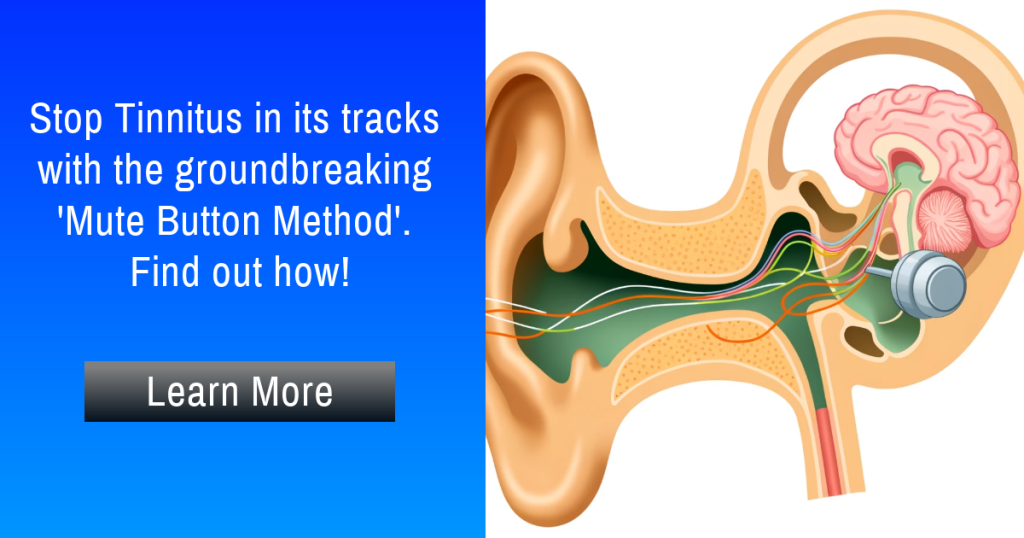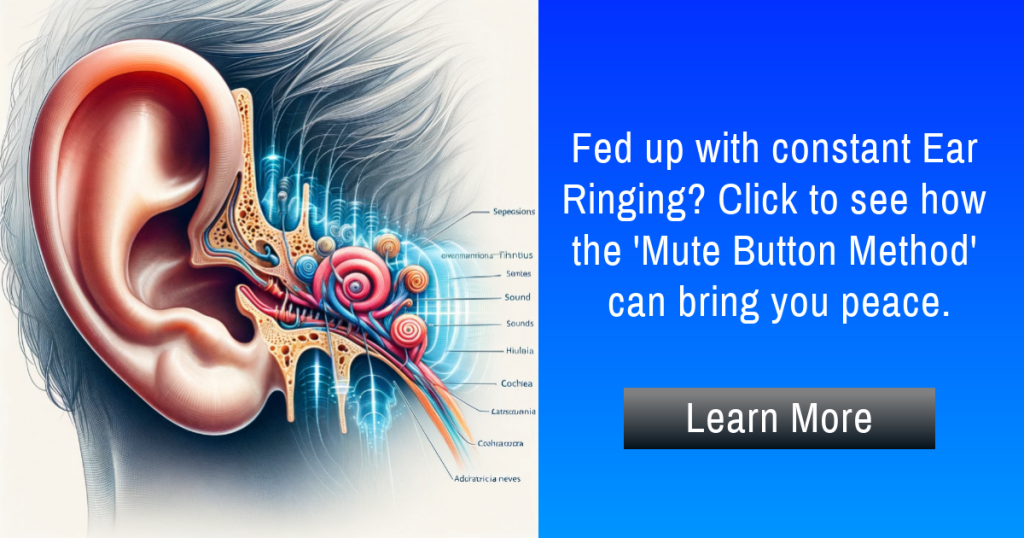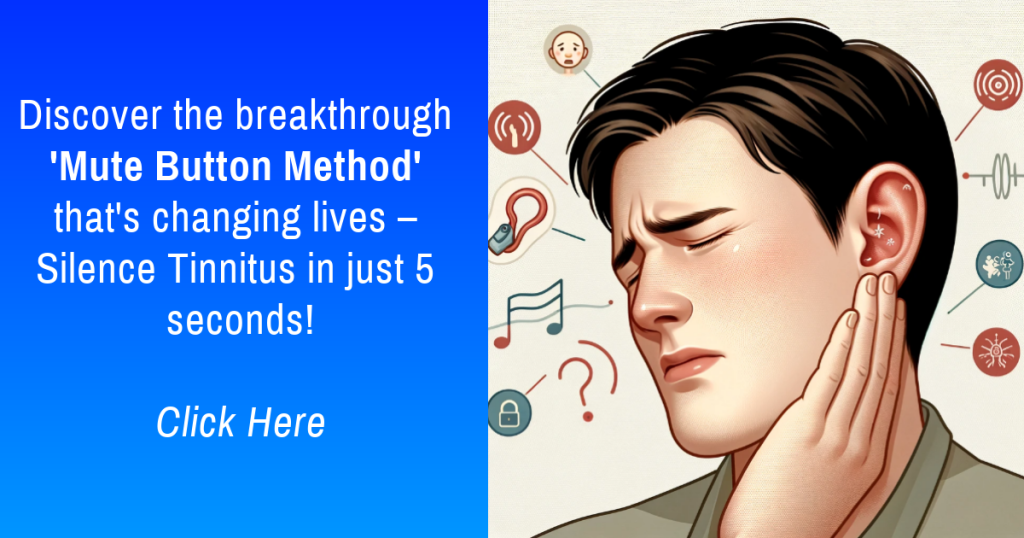- Introduction
- Understanding Tinnitus
- The Problem with Conventional Treatments
- The 5-Second ‘Mute Button Method’: A Closer Look
- Credible Sources Behind the Discovery
- What the Discovery Uncovered
- Main Benefits of the Solution
- Side Benefits: Beyond Tinnitus Relief
- Critical Considerations and Additional Notes
- Conclusion
- FAQs about the 5-Second ‘Mute Button Method’ for Tinnitus
Introduction
Tinnitus, a condition marked by ringing, buzzing, hissing, or other phantom noises in the ears, affects millions worldwide. Unlike sounds caused by external sources, tinnitus originates within the auditory system, making it a perplexing and often distressing condition for those affected. Its impact on sufferers can be profound, ranging from mild annoyance to severe disruption of daily life, affecting concentration, sleep quality, and emotional well-being. Traditional treatments for tinnitus, such as sound therapy, hearing aids, and medications, often aim to manage symptoms rather than resolve the underlying issue. Unfortunately, these methods can fall short for many, leaving individuals in search of more effective solutions.
Enter the discovery of the 5-second ‘Mute Button Method,’ a potentially revolutionary approach that promises not just to manage but to silence tinnitus. Rooted in a deeper understanding of the condition’s origins, this method targets the neurological imbalances believed to contribute to tinnitus. Unlike conventional treatments that offer temporary relief, the ‘Mute Button Method’ aims to provide a lasting solution by addressing tinnitus at its source. Its simplicity and speed of efficacy represent a significant breakthrough, offering hope to those who have struggled with the persistent and often debilitating effects of tinnitus. As we delve deeper into this innovative approach, it’s essential to explore its foundation, efficacy, and how it compares to the limitations of traditional tinnitus treatments, shedding light on why it could be the groundbreaking solution many have been waiting for.
Understanding Tinnitus
Tinnitus is a common auditory condition characterized by the perception of noise or ringing in the ears when no external sound is present. The sounds heard by those with tinnitus can vary widely; some describe it as ringing, while others may hear hissing, buzzing, whistling, or even clicking. The intensity of these sounds can fluctuate, ranging from barely noticeable background noise to a loud and incessant sound that can interfere with daily activities and significantly impact an individual’s quality of life.
Common Symptoms and Causes
The primary symptom of tinnitus is the hearing of sound when no external sound exists. This phantom noise can affect one or both ears and may be constant or intermittent. Tinnitus is often associated with hearing loss, though it can occur without any apparent cause. The causes of tinnitus are diverse and can include exposure to loud noises, which can damage the cells of the inner ear; age-related hearing loss; ear infections or blockages; head or neck injuries; certain medications that can affect hearing; and various health conditions, such as cardiovascular diseases or diabetes.
Complexity of the Condition
Tinnitus’s complexity lies in its varied causes and the subjective experience of the condition. Because tinnitus can stem from so many different factors, identifying a single treatment approach that works for everyone is challenging. The subjective nature of tinnitus—what it sounds like, how loud it is, and how much it bothers the person experiencing it—also complicates treatment. For some, tinnitus is a mild annoyance, while for others, it can be debilitating, leading to concentration difficulties, sleep disturbances, anxiety, and depression.
Challenges in Treatment
Treating tinnitus has been a significant challenge for the medical community for several reasons. First, there is no one-size-fits-all solution, as the effectiveness of treatments can vary widely among individuals. Traditional approaches, such as sound therapy, use external sounds to mask the tinnitus perception, providing temporary relief but not addressing the underlying cause. Hearing aids can amplify external sounds, making tinnitus less noticeable, but again, this does not cure the condition. Medications may relieve the stress, anxiety, or depression associated with tinnitus but do not eliminate the sound itself.
The lack of a universally effective treatment is partly due to our incomplete understanding of tinnitus’s physiological and neurological bases. Recent research suggests that tinnitus may involve complex interactions within the auditory system and between the auditory system and the brain. This has led to the exploration of treatments that target the brain’s involvement in tinnitus, such as the 5-second ‘Mute Button Method,’ which promises a more direct approach to silencing the condition by addressing its root causes at the neurological level.
In summary, the complexity of tinnitus, with its varied causes and personal impact, poses significant challenges in developing effective treatments. However, advances in our understanding of the condition and innovative approaches like the ‘Mute Button Method’ offer new hope for those seeking relief from this often persistent and frustrating condition.

The Problem with Conventional Treatments
Tinnitus has been a longstanding challenge in the medical field, not least because of the limitations associated with its conventional treatments. These treatments, while varied, often share a common shortfall: they tend to manage the symptoms of tinnitus rather than addressing its underlying causes. This section delves into the typical approaches to treating tinnitus and explores why a more definitive solution has been sought after by both the medical community and those affected by the condition.
Overview of Typical Tinnitus Treatments
Conventional treatments for tinnitus include sound therapy, hearing aids, tinnitus retraining therapy (TRT), and pharmacological interventions. Sound therapy uses external noise to mask the tinnitus sound, providing temporary relief. Hearing aids can amplify external sounds, making the tinnitus less noticeable. TRT combines sound masking with counseling to help individuals become less aware of their tinnitus. Pharmacological treatments, meanwhile, aim to alleviate the anxiety and depression that often accompany tinnitus but do not directly reduce the tinnitus sound itself.
Shortcomings of Conventional Treatments
The primary limitation of these treatments is their symptomatic focus. While they may offer temporary relief or help sufferers cope with the condition, they do not cure tinnitus. For many individuals, this means living with a potentially lifelong condition, punctuated by periods of significant distress and impact on their quality of life.
Sound therapy and hearing aids, for example, require continuous use and do not offer a permanent solution. TRT can be a lengthy process with varying results, and its effectiveness is highly individual. Pharmacological interventions, while helpful in managing associated symptoms like anxiety, do not address the tinnitus sound directly and can come with side effects.
Moreover, these treatments do not tackle the diverse and complex causes of tinnitus, which can include auditory system damage, neurological changes, or issues with brain function. As a result, they may not be effective for all individuals, particularly those whose tinnitus stems from less well-understood or addressed causes.
The Need for a Solution that Addresses the Root Cause
Given these limitations, there is a clear and pressing need for a solution that goes beyond symptom management to address the root cause of tinnitus. Such a solution would not only provide more lasting relief but could also prevent the onset of tinnitus in individuals at risk. Understanding and targeting the underlying mechanisms of tinnitus—whether they are related to inner ear damage, neurological changes, or other factors—would represent a significant breakthrough in tinnitus treatment.
The search for a root cause solution is driven by the desire for a more definitive and permanent resolution to tinnitus. By focusing on the cause rather than the symptoms, it is hoped that individuals can achieve not just temporary relief, but a life free from the burdens of tinnitus. This approach aligns with broader shifts in medical treatment towards personalized and cause-focused therapies, offering hope for a future where tinnitus can be effectively silenced.
The 5-Second ‘Mute Button Method’: A Closer Look
The 5-Second ‘Mute Button Method’ represents a novel approach in the fight against tinnitus, diverging from traditional treatments that often focus on symptom management rather than addressing the root cause. This method, emerging from recent breakthroughs in understanding tinnitus, promises not just to mask the symptoms but to silence them, offering a new hope for those suffering from this persistent condition.
Unique Approach to Silencing Tinnitus
The ‘Mute Button Method’ is predicated on the idea that tinnitus is not solely an auditory issue but is closely linked with neurological imbalances within the brain. Specifically, it targets the dysfunctional communication between the ear and the brain, which is believed to be at the heart of tinnitus. By focusing on this aspect, the method aims to rectify the underlying cause of tinnitus rather than merely drowning out the noise with external sounds or coping mechanisms.
This approach is revolutionary in its simplicity and speed, hence the name ‘5-Second Mute Button Method.’ It suggests that with just a few seconds of application, individuals can activate this metaphorical mute button, leading to an immediate reduction or complete cessation of the tinnitus noise. This rapid action contrasts sharply with the prolonged use and gradual effects typically associated with conventional tinnitus treatments.
Claimed Benefits
The primary benefit touted by proponents of the ‘Mute Button Method’ is the immediate relief from the ear ringing, buzzing, hissing, or other phantom noises characteristic of tinnitus. This swift alleviation of symptoms is a significant departure from other treatments that may require continuous application or use to maintain symptom relief.
Beyond the immediate relief, the method also claims to offer the restoration of normal hearing. This benefit is particularly compelling as it suggests that the method can not only silence tinnitus but also reverse some of the auditory system changes associated with the condition, potentially restoring the ear’s natural ability to perceive external sounds without interference.
These claimed benefits—if proven to be effective—represent a substantial advancement in tinnitus treatment, moving beyond mere management to potentially offer a real solution to the millions affected by tinnitus worldwide. The promise of immediate relief and the restoration of normal hearing through a simple, quick application could change the landscape of tinnitus treatment, offering a brighter, quieter future for those who have long sought silence.
Credible Sources Behind the Discovery
The emergence of the 5-Second ‘Mute Button Method’ as a potential breakthrough in tinnitus treatment has been underpinned by references to prestigious institutions and studies, notably those associated with Harvard University and the American Tinnitus Association. These references play a critical role in lending credibility and scientific backing to the method’s claimed effectiveness, helping to bridge the gap between innovative solutions and established medical knowledge.
Harvard University’s Involvement
Harvard University, renowned for its leading-edge research and medical insights, is cited as a key contributor to the foundational research underlying the ‘Mute Button Method.’ Studies conducted or supported by Harvard are often at the forefront of medical innovation, providing a solid scientific basis for new treatments and therapies. In the context of tinnitus, research from Harvard that explores the neurological underpinnings of the condition or that validates the efficacy of novel approaches like the ‘Mute Button Method’ offers significant validation. It suggests that the method is grounded in reputable scientific investigation, enhancing its legitimacy and potential acceptance within the broader medical community.
The American Tinnitus Association’s Support
The American Tinnitus Association (ATA), a leading organization dedicated to tinnitus research, awareness, and support, is another critical source of credibility for the ‘Mute Button Method.’ The ATA’s involvement or endorsement indicates that the method aligns with current understandings of tinnitus and represents a promising avenue for treatment. The organization’s focus on funding tinnitus research, advocating for effective treatment options, and supporting individuals affected by tinnitus means that any method receiving its recognition is likely to be both scientifically sound and focused on genuinely improving patients’ lives.
The Importance of Credible Backing
The association of the ‘Mute Button Method’ with such reputable sources is crucial for several reasons. First, it helps to assure patients and medical professionals alike that the method is not merely anecdotal or experimental but is based on solid scientific principles and research. Second, it provides a level of assurance that the method has been scrutinized by leading experts in the field, lending it a legitimacy that can be crucial for widespread acceptance and use.
Moreover, references to studies and endorsements from institutions like Harvard and the ATA can encourage further research and investigation into the ‘Mute Button Method,’ potentially leading to more refined treatments and a deeper understanding of tinnitus. As with any medical advancement, the journey from discovery to mainstream acceptance involves rigorous testing, validation, and continuous improvement, with credible sources playing a pivotal role in guiding this process.
In summary, the credibility lent by Harvard University and the American Tinnitus Association is a cornerstone of the ‘Mute Button Method’s’ potential impact on tinnitus treatment. It signals a promising convergence of innovative solutions and established medical research, offering hope for a future where tinnitus can be effectively silenced.

What the Discovery Uncovered
The discovery surrounding the 5-Second ‘Mute Button Method’ brought to light several key insights that significantly advance our understanding of tinnitus and its treatment. Central to this discovery is the elucidation of the intricate link between tinnitus and broader issues of brain health, particularly the chemical imbalances that may underlie the condition. This breakthrough not only challenges conventional perspectives on tinnitus but also opens the door to novel treatment approaches that target the condition’s root causes.
The Link Between Tinnitus and Brain Health
The research behind the ‘Mute Button Method’ highlights a critical connection between the persistent sounds characteristic of tinnitus and underlying neurological imbalances. Specifically, it suggests that tinnitus is not merely an issue of the auditory system but also involves complex interactions within the brain’s neural networks. This perspective points to chemical imbalances in the brain, such as discrepancies in neurotransmitter levels, as potential contributors to the development and persistence of tinnitus.
One pivotal insight is the role of neurotransmitters like GABA (gamma-aminobutyric acid) and glutamate, which are essential for regulating neuronal activity and auditory processing. An imbalance between these neurotransmitters can lead to excessive neural activity, which may be perceived as the phantom sounds characteristic of tinnitus. This understanding signifies a shift from viewing tinnitus as an isolated auditory issue to recognizing it as a symptom of broader neurochemical dysregulation.
Rebalancing Brain Chemistry as a Solution
Building on these insights, the ‘Mute Button Method’ aims to address tinnitus at its source by rebalancing the brain’s chemistry. The method posits that by restoring equilibrium between key neurotransmitters, it’s possible to reduce or eliminate the aberrant neural activity responsible for tinnitus. This approach represents a significant departure from traditional treatments that focus on managing symptoms, offering a more definitive and lasting solution to the condition.
The method’s efficacy hinges on its ability to modulate the levels of neurotransmitters, enhancing the inhibitory actions of GABA, for instance, while regulating the excitatory effects of glutamate. By doing so, it seeks to normalize the neural circuits that have become dysregulated in individuals with tinnitus. This not only has the potential to silence the unwanted sounds of tinnitus but also to improve overall brain function and health, given the critical roles these neurotransmitters play in various cognitive processes.
In essence, the discovery underlying the ‘Mute Button Method’ sheds new light on the complex interplay between tinnitus and brain health, offering a hopeful path forward for millions of sufferers. By targeting the neurochemical imbalances at the heart of tinnitus, this innovative approach promises a more holistic and effective solution to a condition that has long eluded conventional treatment strategies.
Main Benefits of the Solution
The 5-Second ‘Mute Button Method’ introduces a revolutionary approach to treating tinnitus, one that diverges significantly from traditional management strategies. This method, grounded in recent discoveries about the neurological underpinnings of tinnitus, offers not just a novel treatment but a suite of benefits that could transform the lives of those afflicted by this condition.
Lasting Relief from Tinnitus
One of the most compelling advantages of the ‘Mute Button Method’ is its potential to provide lasting relief from tinnitus. Unlike conventional treatments that often offer temporary respite or require ongoing intervention, this method aims to address the root cause of tinnitus by rebalancing the brain’s chemistry. By targeting the neurochemical imbalances believed to contribute to the condition, the method seeks to reduce or entirely eliminate the phantom sounds characteristic of tinnitus. This approach not only promises an end to the incessant noises but also the possibility of a permanent solution, offering hope for a future free from the burdens of tinnitus.
Broader Implications for Brain Health and Cognitive Function
The benefits of the ‘Mute Button Method’ extend beyond the silencing of tinnitus, touching on broader aspects of brain health and cognitive function. The method’s focus on rebalancing neurotransmitters has implications for neural circuitry and brain function as a whole. Neurotransmitters like GABA and glutamate play pivotal roles in regulating mood, anxiety, sleep, and cognitive processes. By restoring equilibrium to these systems, the method may not only alleviate tinnitus but also enhance cognitive functions, improve mood stability, and promote better sleep patterns.
Moreover, by addressing the neurochemical dysregulation associated with tinnitus, the method could potentially mitigate the risk of developing other neurological conditions linked to neurotransmitter imbalances, such as anxiety disorders, depression, and cognitive decline. This preventative aspect underscores the method’s holistic approach to health, viewing tinnitus not just as an isolated issue but as part of the broader landscape of neurological well-being.
The ‘Mute Button Method’s’ focus on brain chemistry also opens new avenues for understanding and treating other conditions with similar neurochemical foundations. As such, its impact could reach beyond individuals with tinnitus, offering insights and potential treatments for a range of neurological and psychiatric conditions.
In summary, the primary benefits of the 5-Second ‘Mute Button Method’ lie in its potential to offer lasting relief from tinnitus and its broader implications for enhancing brain health and cognitive function. By moving beyond symptom management to address the underlying causes of tinnitus, this innovative approach promises not just to silence the noise but to improve the overall quality of life for those affected, marking a significant leap forward in our understanding and treatment of this complex condition.
Side Benefits: Beyond Tinnitus Relief
The 5-Second ‘Mute Button Method’ not only holds promise for silencing the persistent and often debilitating sounds of tinnitus but also offers a spectrum of additional benefits that extend well beyond the primary goal of tinnitus relief. These ancillary advantages emerge from the method’s underlying approach to rebalancing brain chemistry, which plays a pivotal role in various mental and physical health aspects. Here, we delve into the reported side benefits, including enhancements in sleep quality, reductions in anxiety levels, and improvements in cognitive abilities.
Improvements in Sleep Quality
One of the most significant side benefits reported by users of the ‘Mute Button Method’ is a marked improvement in sleep quality. Tinnitus can severely disrupt sleep patterns, with the incessant ringing leading to difficulties in falling asleep and staying asleep. By effectively reducing or eliminating the tinnitus sound, individuals can experience a quieter environment conducive to sleep. Furthermore, the rebalancing of neurotransmitters may also directly contribute to more regulated sleep cycles, allowing for deeper and more restorative sleep. This enhancement in sleep quality is critical, as good sleep is foundational to overall health, affecting everything from mood regulation to cognitive function and physical health.
Reduction in Anxiety Levels
Anxiety and tinnitus often go hand in hand, with the stress of coping with tinnitus exacerbating anxiety levels, and heightened anxiety in turn worsening tinnitus symptoms. The ‘Mute Button Method’, by addressing the root cause of tinnitus, can break this vicious cycle. The neurochemical rebalance achieved through the method not only aims to silence tinnitus but also stabilizes the brain’s mood-regulating mechanisms. This stabilization can lead to a significant reduction in anxiety levels, providing a sense of calm and well-being that extends beyond the mere absence of tinnitus sounds.
Enhanced Cognitive Abilities
Another notable side benefit of the ‘Mute Button Method’ is the enhancement of cognitive abilities. Tinnitus can impair cognitive functions, making concentration, memory retention, and problem-solving more challenging. By alleviating the constant distraction of tinnitus, individuals can experience improved focus and clarity of thought. Additionally, the method’s action on neurotransmitter balance can further enhance cognitive functions. Neurotransmitters like GABA and glutamate are crucial for cognitive processes, and their rebalancing can lead to better memory, faster processing speeds, and improved overall cognitive performance.
These side benefits underscore the ‘Mute Button Method’s’ holistic impact on individuals’ health and well-being. By moving beyond the singular aim of tinnitus relief to address the interconnected aspects of brain health, the method offers a comprehensive approach to wellness. The improvements in sleep quality, reductions in anxiety, and enhancements in cognitive abilities not only contribute to a better quality of life for those affected by tinnitus but also highlight the method’s potential as a transformative health intervention.

Critical Considerations and Additional Notes
While the 5-Second ‘Mute Button Method’ presents a promising approach to treating tinnitus, it’s essential for individuals to approach it with a critical eye and consider several key factors before embracing it as a solution. Understanding the nuances of the method, its claims, and the broader context of tinnitus treatment can help ensure that individuals make informed decisions about their health care.
Critically Evaluating the Claims
- Research the Evidence: Look for peer-reviewed studies or clinical trial results that support the claims made about the method. Reliable evidence should be transparent, accessible, and from reputable sources.
- Understand the Mechanism: Seek a clear explanation of how the method works. Effective treatments should have a well-defined mechanism of action that aligns with current scientific understanding.
- Compare with Existing Treatments: Consider how the method compares to established treatments for tinnitus. New treatments should offer clear advantages in terms of efficacy, safety, and convenience.
- Be Wary of Quick Fixes: Approach promises of immediate and effortless cures with caution. Effective medical treatments typically require rigorous testing and validation.
Consulting Healthcare Professionals
Before trying new treatments, including the ‘Mute Button Method’, consulting with healthcare professionals is crucial.
- Personalized Medical Advice: A healthcare provider can offer advice tailored to your specific health condition, medical history, and treatment needs.
- Safety and Interactions: Professionals can help assess the safety of new treatments and their potential interactions with existing medications or health conditions.
- Alternative Options: Healthcare providers can suggest other treatment options if a new method may not be suitable for your particular case.
Emphasizing Evidence-Based Approaches
Adopting evidence-based approaches to treatment is fundamental in ensuring both efficacy and safety.
- Scientific Validation: Prioritize treatments that have undergone scientific validation and are supported by credible research.
- Regulatory Approval: Look for treatments that have received approval from regulatory bodies, such as the FDA, which indicates a certain level of scrutiny and validation.
- Professional Endorsements: Consider whether respected medical organizations or institutions endorse the method.
Managing Expectations
Setting realistic expectations is important when exploring new treatments.
- No Universal Cures: Recognize that what works for one person may not work for another due to the complex nature of tinnitus.
- Progress Over Perfection: Understand that improvement may be gradual and that managing symptoms effectively is a significant step forward.
- Long-Term Perspective: Consider the long-term implications of treatment choices, including potential side effects and overall health outcomes.
In summary, while the ‘Mute Button Method’ for tinnitus offers hope for many sufferers, approaching it with a critical and informed perspective is essential. By evaluating the claims, consulting healthcare professionals, embracing evidence-based approaches, and managing expectations, individuals can make informed decisions about their tinnitus treatment and overall health.

Conclusion
The introduction of the 5-Second ‘Mute Button Method’ has sparked considerable interest and hope among those affected by tinnitus, offering a potentially groundbreaking solution to an ailment that has long challenged the medical community. This method, distinguished by its simplicity and rapid action, suggests a significant departure from traditional approaches to tinnitus treatment, promising not only relief from the persistent and often debilitating symptoms but also a deeper resolution addressing the condition’s root causes.
The allure of a quick and effective solution to tinnitus cannot be understated. The prospect of silencing the incessant ringing or buzzing in mere seconds, as proposed by the ‘Mute Button Method’, represents a beacon of hope for millions worldwide. It brings forward the possibility of regaining a sense of normalcy, enhancing quality of life, and freeing individuals from the constant distraction and distress that tinnitus can impose.
However, as we navigate the landscape of new and emerging treatments, it is imperative to approach the ‘Mute Button Method’ and similar solutions with informed caution. The enthusiasm for innovative treatments should be balanced with a diligent pursuit of evidence and a thorough understanding of the method’s scientific backing, mechanism of action, and potential outcomes. It is crucial to critically evaluate the claims made, seeking out peer-reviewed research, clinical trial results, and endorsements from reputable medical institutions that can validate the method’s efficacy and safety.
Moreover, consulting with healthcare professionals remains an essential step in exploring new treatments for tinnitus. Medical advice from experts familiar with your individual health history, conditions, and treatment goals is invaluable. Healthcare providers can offer personalized insights, assess the suitability of new treatments, and guide you toward the most effective and safe options for managing tinnitus.
In conclusion, the ‘Mute Button Method’ presents a promising avenue for tinnitus treatment, potentially heralding a new era in the management of this complex condition. Its promise of rapid, effective relief aligns with the desires of many seeking an end to their tinnitus symptoms. Yet, the journey toward adopting new treatments should be navigated with care, prioritizing evidence-based approaches, professional guidance, and a well-rounded understanding of the benefits and limitations. By doing so, tinnitus sufferers can make informed decisions that best support their health, well-being, and journey toward silence.

FAQs about the 5-Second ‘Mute Button Method’ for Tinnitus
What is tinnitus and how does it affect individuals?
- Tinnitus is a condition characterized by hearing noises like ringing, buzzing, or hissing in the ears when no external sound is present. It can significantly impact an individual’s quality of life, causing distress, difficulty concentrating, and sleep problems.
What makes the 5-second ‘Mute Button Method’ different from other tinnitus treatments?
- This method claims to address the root cause of tinnitus by targeting a chemical imbalance in the brain, unlike many traditional treatments that focus only on symptom management.
Are there any scientific studies supporting this method?
- The method is said to be backed by research from reputable institutions such as Harvard and the American Tinnitus Association, which suggest its potential effectiveness in silencing tinnitus.
Can this method cure tinnitus permanently?
- While the method claims to provide significant relief from tinnitus by addressing its underlying causes, individual results may vary, and it’s essential to consult healthcare professionals for a comprehensive approach.
Is the ‘Mute Button Method’ safe to use?
- The method is presented as a natural solution, which implies safety. However, individuals should consult with a healthcare provider before trying new treatments, especially if they have existing health conditions or are taking medication.
How quickly can one expect to see results?
- Some claims suggest that individuals may experience relief from tinnitus symptoms within days of using the method, but results can vary based on the individual’s specific condition and health factors.
Who can benefit from this method?
- The method is claimed to be universally effective, potentially benefiting anyone suffering from tinnitus, regardless of the duration or severity of their condition.
Are there any side benefits to using this method?
- Beyond silencing tinnitus, the method is also said to offer additional benefits, including improved brain health, enhanced cognitive function, reduced anxiety, and better sleep quality.
What should I do if the method doesn’t work for me?
- It’s important to have realistic expectations and understand that treatments can have varied effects. If the method does not provide relief, consult with a healthcare professional to explore other treatment options. There is also a 365 Day Money Back Guarantee.
How can I access the 5-second ‘Mute Button Method’?
– You can access it by clicking here.

You can also view a detailed explanation of the 5-Second Mute Button Method by clicking here.











